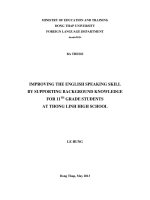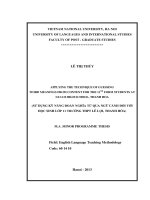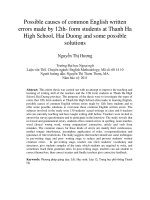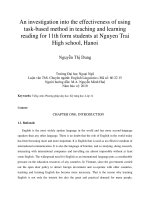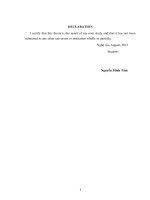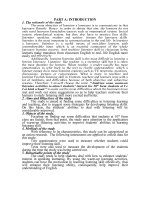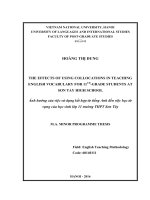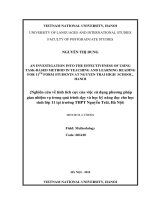Applying the technique of guessing word meanings from context for 11th form students at Le Loi high school = Sử dụng kỹ năng đoán nghĩa từ qua ngữ cảnh đối với
Bạn đang xem bản rút gọn của tài liệu. Xem và tải ngay bản đầy đủ của tài liệu tại đây (913.71 KB, 68 trang )
VIETNAM NATIONAL UNIVERSITY, HA NOI
UNIVERSITY OF LANGUAGES AND INTERNATIONAL STUDIES
FACULTY OF POST - GRADUATE STUDIES
************************
LÊ THỊ THỦY
APPLYING THE TECHNIQUE OF GUESSING
WORD MEANINGS FROM CONTEXT FOR THE 11
TH
FORM STUDENTS AT
LE LOI HIGH SCHOOL, THANH HOA
(SỬ DỤNG KỸ NĂNG ĐOÁN NGHĨA TỪ QUA NGỮ CẢNH ĐỐI VỚI
HỌC SINH LỚP 11 TRƯỜNG THPT LÊ LỢI, THANH HÓA)
M.A .MINOR PROGRAMME THESIS
Field: English Language Teaching Methodology
Code: 60 14 10
Hanoi - 2013
VIETNAM NATIONAL UNIVERSITY, HA NOI
UNIVERSITY OF LANGUAGES AND INTERNATIONAL STUDIES
FACULTY OF POST - GRADUATE STUDIES
*************************
LÊ THỊ THỦY
APPLYING THE TECHNIQUE OF GUESSING
WORD MEANINGS FROM CONTEXT FOR THE 11
TH
FORM
STUDENTS AT LE LOI HIGH SCHOOL, THANH HOA
(SỬ DỤNG KỸ NĂNG ĐOÁN NGHĨA TỪ QUA NGỮ CẢNH ĐỐI VỚI
HỌC SINH LỚP 11 TRƯỜNG THPT LÊ LỢI, THANH HÓA)
M.A. MINOR PROGRAMME THESIS
Field: English Language Teaching Methodology
Code: 60 14 10
Supervisor: Dr. Lâm Quang Đông
Hanoi – 2013
iv
LIST OF CHARTS AND TABLES
Chart 1: Result of the pre-test
Chart 2: Result of post-test 1
Chart 3: Result of post-test 2
Table 1: The effectiveness of the guessing technique.
v
TABLE OF CONTENT
DECLARATION i
ACKNOWLEDGEMENTS ii
ABSTRACT iii
LIST OF CHARTS AND TABLES iv
TABLE OF CONTENT v
PART A: INTRODUCTION 1
The rationale of the study 1
Aims and Objectives of the study 2
Significance of the study 2
Research questions 2
Methods of the study 3
Scope of the study 3
PART B: DEVELOPMENT 4
CHAPTER I: LITERATURE REVIEW 4
I.1. Definition of context 4
I.2. Guessing or inferring strategy 5
I.3 Guessing word meanings from context as a technique of vocabulary
teaching and learning 5
I.4. Previous studies on guessing word meanings from context 7
I.5. Types of context clues used in guessing word meanings 9
I.5.1. Structural clues 9
I.5.2. Inference clues 10
I.6. Approach to teaching of guessing technique 10
I.7. Vocabulary in English textbook for 11
th
graders 11
I.8. Summary 12
CHAPTER II: METHODOLOGY 13
II.1. Rationale for the use of an action research 13
vi
II.2. Action research procedure 13
II.3. Background of the study 15
II.3.1. Participants 15
II.3.2. Data collection instruments 16
II.3.2.1. Tests 16
II.3.2.2. Students‟ diaries 16
II.3.2.3. Questionnaire 16
II.3.2.4. Focus group interview 16
II.4. Data collection procedures 17
II.5. Applying the guessing technique from context to teaching English
vocabulary to 11
th
learners 20
II.5.1. Activities for presenting vocabulary 21
II.5.1.1. Real objects, picture 21
II.5.1.2. Demonstration, miming 21
II.5.1.3. Giving examples 21
II.5.1.4. Giving synonyms, antonyms 22
II.5.1.5. Contextual guesswork 22
II.5.2. Activities for controlled practice stage 23
II.5.2.1. Sentence-making 23
II.5.2.2. Gap-filling 23
II.5.2.3. Fill in the blank with the right form of the word 25
II.5.2.4. Translation 25
II.5.2.5. Matching 26
II.5.3. Activities for free practice stage 26
II.5.3.1. Word-games 27
II.5.3.2.Topic discussion 27
II.6. Summary 28
CHAPTER III: DATA ANALYSIS AND DISCUSSION 28
III.1. The results of the pre-test 28
vii
III.2. The results after the training period 29
III.2.1. The results of students’ diaries 29
III.2.2. The results of the post-tests 29
III.2.3. The results of the questionnaire 31
III.2.4. The results of focus group interview 33
III.3. Summary 35
PART C: CONCLUSION 37
1. Summary of the findings 37
2. Conclusions 38
3. Limitations of the study 39
4. Suggestions for further research 39
REFERENCES 40
APPENDIX A: PRE-TEST AND POST-TEST 1 I
APPENDIX B: POST-TEST 2 VI
APPENDIX C: TRAINING LESSON 1 XI
APPENDIX D: TRAINING LESSON 2 XIV
APPENDIX E: TRAINING LESSON 3 XVII
APPENDIX F: QUESTIONNAIRE FOR STUDENTS XIX
APPENDIX G: AN EXAMPLE FROM STUDENTS’ DIARIES XX
1
PART A: INTRODUCTION
1. The rationale of the study
Vocabulary is an essential component of language, which plays a decisive
role in communication. Wilkins, a famous British applied linguist, emphasized this
with his saying "without grammar, very little can be conveyed, without vocabulary
nothing can be conveyed" (1972:111). Obviously, words do not occur in isolation
but within the context of sentence or a large discourse. Also, a word used in
different contexts may have different meanings; thus, simply learning the
definitions of a word without examples of where and when the word occurs will not
help learners to fully understand its meaning. Learning an isolated list of words
without reference to the context is merely a memorization exercise which makes it
difficult for learners to use the words in spoken and written language.
In fact, students in general and Le Loi High School students in particular
often have a habit of looking up word meanings in dictionaries without
understanding how to use them. Too much dictionary work can kill all interests in
reading and even interfere with comprehension, because readers become more
concerned with individual words and less aware of the context which gives them
meaning. Therefore, Le Loi High School students find it difficult to globally
understand spoken or written discourse, most probably because they lack the ability
to guess word meanings from context. Many students tend to ignore unknown
words, which is thought completely problematic to vocabulary learning. Using the
contexts in which words appear, that is, a sentence in which the words to be learned
appears will help students derive the meaning of these unknown words. Therefore,
this problem is well worth taking into consideration.
Although it is evident that the use of contextual clues can be effective in
learning and teaching English vocabulary and provide a means by which students
can quickly increase their existing vocabulary base, it has not attracted much
2
attention in terms of classroom instruction. Some researches on the techniques of
teaching vocabulary have mentioned this technique as a good one but little attempt
has been made to integrate this technique training into normal teaching. Even little
has been made to investigate the usefulness of developing students' techniques for
guessing unknown words through context on the improvement of their proficiency
in using vocabulary. All these have motivated the researcher to carry out an action
research on applying the technique of guessing word meanings from context for 11
th
graders at Le Loi high school.
2. Aims and Objectives of the study
The study is aimed at applying the technique of guessing word meanings to
teaching vocabulary so that students can understand word meanings as well as their
form and then use them correctly. On this basis, possible suggestions for improved
effectiveness in students‟ vocabulary learning can be derived.
3. Significance of the study
The present research is carried out to encourage students to deal with word
meanings with the help of context. It is also carried out with the hope that it would
help teachers as well as 11
th
graders at Le Loi High School be aware of the
important role of the guessing skill as well as some guessing techniques used in
teaching and learning vocabulary. Moreover, it is hoped that the study could help
the 11
th
graders in particular and high school students in general improve their
vocabulary and use vocabulary correctly and fluently.
4. Research questions
This study was conducted to answer the following major research question:
- How effective is the technique of guessing word meanings from context in helping
11
th
graders at Le Loi High School learn vocabulary?
3
5. Methods of the study
With reference to its characteristics, this thesis can be categorized as an
action research. The following instruments are applied to collect data for this study:
One pre-test and two post-tests were used to measure whether students could
improve their vocabulary.
A questionnaire of 7 questions was given to the students to find out their
opinions about the effectiveness of guessing technique in understanding word
meanings. Interviews were conducted after 6 weeks of training to obtain more in-
depth data about how students assessed their progress when applying guessing
technique and how this technique affected their vocabulary learning.
Students‟ diaries were also used to support this action research. Students
were asked to write reflective journals to express their reflections on the guessing
technique. The students‟ diaries were collected after every 2 weeks of training and
then were analyzed to find out what the students thought about the technique of
guessing word meanings from context.
6. Scope of the study
The study is concerned with the application of the skill to guess word
meanings from context in teaching and learning vocabulary so as to measure the
degree of effectiveness of this technique in improving students‟ vocabulary. The
study only focuses on 11
th
graders at Le Loi High School, so the results of the study,
though highly expected, may not be readily applied for all students at high schools.
4
PART B: DEVELOPMENT
CHAPTER I: LITERATURE REVIEW
In this chapter, the author will clarify several concepts concerning the
technique of guessing word meanings from context. In addition, different issues
relating to this technique will also be presented.
I.1. Definition of context.
Context (language context) means “textual or discoursal place in which a
particular word or structure can be found” (Gu, 2003:2). It can be as short as a
sentence or as long as several paragraphs, and it will usually contain unknown
words (Rapaport, 2003). Context refers to the words surrounding an unfamiliar
word. These surrounding words provide clues to the meaning of an unfamiliar word.
Traditionally, context was seen as a given, existing fully and completely in any
properly written text and the key to using it was linguistic knowledge and it plays a
very important role in the identification of words in text. A word used in different
contexts may have different meaning so simply learning the definition of a word
without examples of where and when it occurs will not help learners to fully
understand its meaning. If learners are not able to contextualize new words by
connecting them to words and concepts they already know, the words will likely be
less meaningful to them. And then if meaning is not contextualized, it will be
difficult for learners to memorize as well as to use new words appropriately.
Bialystok (1983) proposes that context exists in relation and proportion to the
reader‟s implicit knowledge (intuitive and unanalyzed knowledge of the second
language), other knowledge (knowledge of other languages and world knowledge),
and context (linguistic and physical aspects of a text which provide clues to
meaning). From this view, context is clearly not an absolute presence in a text but is
created by the reader, and is therefore influenced by the reader‟s linguistic and
world knowledge.
5
In short, context includes both linguistic and non-linguistic aspects.
Therefore, in order to derive the meaning of a word from context, learners need to
utilize not only the information presented in the text but also their general
knowledge of the topic discussed in the text.
I.2. Guessing or inferring strategy
Guessing word meanings from context most commonly refers to inferring the
meanings of a word from surrounding words in a written text. It is an active and
deliberate process to acquire a meaning for a word in a text, “By reasoning from
textual clues and prior knowledge, including language knowledge and hypotheses
developed from prior encounters with the word, but without external sources of help
such as dictionaries or human.” (Rapaport, 2005).
Grellet (1981) defined guessing as “inferring means making use of syntactic,
logical and cultural clues to discover the meaning of unknown elements”. McCarthy
(1990) gave another definition: “Inferring involves creating a schema for the
unknown words, based on world knowledge and previous experience, both of the
world and texts. In other words, inferring means drawing conclusions as to word
meaning by following certain rational steps in the face of the evidence available”.
Gairns and Redman (1986) use the term “contextual guesswork” for the strategy of
making use of context in which the word appears to derive an idea of its meaning or
in some cases from the word itself.
To conclude, the guessing strategy is quite sophisticated but it plays a very
important part in vocabulary development. Thus, it has been widely promoted as it
has been seen to fit in more comfortably with the communicative approach than any
other.
I.3 Guessing word meanings from context as a technique of vocabulary
teaching and learning
6
Guessing word meanings from context is one of many available vocabulary
learning techniques. This technique is regarded as “the most important of all
sources of vocabulary learning” (Nation, 2001:232). Teaching meanings of single
words out of context does not yield good learning outcomes because of the
polysemous nature of words. Thornbury (2002) adds that guessing from the context
is one of the most useful skills learners can acquire and apply inside and outside
classroom and, more importantly, can be taught and implemented relatively easily
(p. 202). Nagy (1997:76) argues that although second-language learners are less
effective than native speakers at using context, they may have a greater need to use
context. The reason is that they encounter unfamiliar words quite more often than
first language readers and are more expected to encounter unfamiliar meanings of
words. Obviously, second language learners are able and have more opportunities to
learn words from context.
Using context clues to understand the meaning of unfamiliar words helps the
reader save time since the reader does not have to look the word up in the dictionary
and that also gives the reader a good sense of how a word is actually used. As Smith
(1971) argued, instead of looking words up in a dictionary, the best way to identify
an unfamiliar word in a text is to draw inferences from the rest of the text. Oxford &
Scarcella (1994) believed that contextualized learning helps learners grasp the full
meaning of a word or phrase and become aware of the linguistic environment in
which the word or phrase appears. A number of other researchers (E.g. Pressley,
Levin & McDaniel, 1987) argued that context is helpful to generate possible
meanings for unknown words but it alone does not foster retention of meanings. To
understand the key words by using guessing meanings from context is a skill that
leads the learners to read effectively and efficiently. Guessing meaning of
unfamiliar words in context is the most practical method to comprehend both
written and oral communication.
7
Given the important role of guessing word meanings from context technique,
it is recommended that the teacher should assist students in learning to recognize
clues to guessing word meaning from context. This vocabulary learning skill is
effective for learning low-frequency vocabulary (Herrel, 2008).
Nagy (1997:76) distinguishes three types of knowledge that readers possess
to contribute to contextual inferring, which include linguistic knowledge, world
knowledge and strategic knowledge. Linguistic knowledge consists of syntactic
knowledge, vocabulary knowledge, and word schema which is knowledge of what
constitutes possible word meanings in a language. Nagy emphasizes vocabulary
knowledge, a key factor affecting readers' ability to make use of context. According
to him, to infer the meaning of any unknown word in context, it is helpful to know
the meaning of the words around it. World knowledge contributes to effective use
of context. The context that helps learners deduce the word meaning must be
construed to consist of the learners' knowledge of the world; learning a word from
context sometimes simply requires determining which of the several already
familiar concepts the word refers to. Strategic knowledge involves conscious
control over cognitive resources. Nagy points out that training students in use of
context has improved their ability to guess the meaning of unknown words.
Guessing the meaning of a word from context involves a relationship between the
situation model and the text model, as well as knowledge of the nature of the
possible mappings between these two things. Moreover, there are a number of
factors which impinge on the effectiveness of the guessing process that researchers
should take into consideration before conducting any study on this sub-skill.
I.4. Previous studies on guessing word meanings from context.
Being one of the most important strategies in acquiring vocabulary
knowledge, the guessing technique has been a great concern of many researchers. A
good number of studies have been carried out and the results have been expressed in
both optimistic and pessimistic views.
8
Research findings about the success of students‟ guessing word meanings
from context are inconclusive. Bensoussan and Laufer (1984) provide a guessing
task which learners had to answer in writing. Their findings show that learners
frequently make wrong guesses. Wrong guesses resulted from giving the incorrect
meaning of a word that had several meanings, or confusing the target word with one
that looked or sounded similar. Particularly, learners have been found to make
guesses, producing an inferred meaning that has little relation to the wider context
of the text. One point needs to be made here, that is the participants of the study
have not been specifically trained to do lexical guessing.
Liu and Nation (1985) were more optimistic after they studied learners‟
ability to guess the meaning of nonsense words used to replace real word at regular
intervals in written texts. They concluded that success was determined by the
relative density of unknown words. Where there was only one nonsense word per
twenty-five words, they were easier to guess than there was one every ten words.
Liu and Nation estimated that at least 85 percent of unknown words could be
guessed by a class of learners working together to pool their relevant knowledge
and skills.
Recently, Redouane (2004) examined the efficacy of the guessing-from-
context strategy versus a word-list strategy in learning French lexical words and
their meanings as well as retention of those words at the university level. The
findings manifested the facilitation role of guessing-from-context strategy in
learning more French words. Moreover, the guessing-from-context technique
proved to have an impact not only on immediate recall but on long-term retention.
After carrying out a quasi-experimental study with the use of two approaches to
vocabulary teaching: Context and Non-context presentation, Zaid (2009) paid more
attention to “teach vocabulary in context” approach, suggesting that EFL
vocabulary should never be taught in isolation as in word lists with their
equivalents.
9
I.5. Types of context clues used in guessing word meanings
Clues help to infer meanings of new words from context. It is impossible to
infer the meanings of new words if the context does not offer enough clues. Both
teachers and students need to be aware of this. Nation (1983) suggests some types
of clues as follows:
I.5.1. Structural clues
Structural clues help to know the kind of meaning of the new words. They
are used to determine the type of grammatical category of new words. They include:
morphology, antonyms, synonyms, hyponyms, definitions, restatement, reference
words, alternatives and punctuation.
Morphology: The students can derive word meanings by examining internal,
morphological features, like prefixes, suffixes, and root words.
Reference words: Identifying the referents of pronouns may provide a clue to the
meaning of an unfamiliar word.
Synonyms and antonyms: Often the reader can find the meaning of new items in
the same sentence.
Hyponyms: Very often the reader can see that the relationship between an
unfamiliar word and a familiar word is that of a general concept accompanied by a
specific example (a hyponym).
Definitions: Sometimes the writer defines the meaning of the word right in the text
as “are/is known as”, “are /is described as”, “are/ is defined as”.
Alternatives: The writer may give an alternative of an unfamiliar word to make the
meaning known.
Restatement: Often the writer gives enough explanation for the meaning to be clear
such as: “in other words”, “that is” and “that is to say”.
10
Punctuation: Readers can also use clues of punctuation and type style to infer
meaning, such as quotation marks (showing the word has a special meaning),
dashes (showing apposition), parentheses or brackets (enclosing a definition), and
italics (showing the word will be defined).
I.5.2. Inference clues
Those types of clues need a higher level of analytical skill and practice than
structural clues. The readers need to use rationale or reasoning skills in order to
figure out the meanings of new words. Inference clues include comparison and
contrast, summary, cause and result, cohesion to understand the word meanings.
Summary: A summary clue sums up a situation or an idea with a word or a phrase.
Comparison and contrast: Writers can show similarity or difference. Key words
“but”, “instead of”, “even though”, “in contrast to”, “yet”, and “in spite of”, “like”,
“in the same way”… are used by the author.
Cohesion: While reading a text, cohesion is maintained through a rich mesh of
contextual clues. The meaning of unknown words can be shown by other words in
the same sentence or in adjacent sentences because they regularly co-occur with the
unfamiliar words. It is called “collocational cohesion” by Halliday and Hassan
(1976: 287)
In conclusion, to make effective guesses, learners need to be trained to look
for clues in context, provided that those clues are sufficient to make inferences
possible and productive.
I.6. Approach to teaching of guessing technique
Although guessing from context is a complex and often difficult technique to
carry out successfully, it may still contribute to vocabulary learning. There are
different approaches to teaching the technique of guessing from context, two of
which are inductive and deductive approach. According to Nation and Coady
11
(1988), teachers can train students the guessing technique with a five-step inductive
procedure:
1. Determine the part of speech of unknown word;
2. Look at the immediate context and simplify it if necessary;
3. Look at the wider context. This entails examining the clause with unknown
word and its relationship to the surrounding clauses and sentences;
4. Guess the meaning of unknown word;
5. Check that the guess is correct.
As can be seen in the mentioned approache, teacher explanation and
modeling of the technique is essential at the beginning stage, followed by student
practice.
I.7. Vocabulary in English textbook for 11
th
graders
In the textbook currently in use for 11
th
graders, vocabulary is taught and
practiced via both materials for language skills development and in its own right in
the Language Focus section. Thus, vocabulary is both taught in meaningful contexts
and further consolidated in form-focused exercises.
In the reading section, vocabulary is taught through activities such as
matching definitions with words, gap-fill, word-form, finding synonyms and
antonyms. However, vocabulary is not practiced as much in other parts of the unit
as expected. Unfortunately, however, some vocabulary is used in speaking and
listening sections, but that vocabulary is not used logically in Language Focus
section. Students do not have much chance to practice the words that they have just
learnt in reading section. Also, many of these activities are not properly designed,
thus they are not highly likely to achieve their purposes.
I.8. Summary
12
In this chapter, an overview of context and guessing technique, types of
context clues, approaches to teaching of guessing technique, guessing word
meanings as a technique to teach English vocabulary, some previous studies on
guessing word meaning and vocabulary in English textbook for 11
th
form have been
presented. A theoretical framework has been prepared for investigation in the next
chapter.
13
CHAPTER II: METHODOLOGY
II.1. Rationale for the use of an action research
“Action research is the application of fact finding to practical problem
solving in a social situation with a view to improving the quality of action within it,
involving the collaboration and cooperation of researchers, practitioners and
laymen” (Burns, 1999: 293). Mills (2003:4) defines action research as “any
systematic inquiry conducted by the teacher researchers to gather information
about their particular school operates how they teach and how their students
learn”. Classroom Action Research is research designed to help a teacher find out
what is happening in his or her classroom, and to use that information to make wise
decisions for the future.
Action research is very beneficial to the teaching and learning process; it
helps to promote personal and professional growth, to improve practice to enhance
student learning, and to advance the teaching profession (Johnson, 1995). The
teacher would solve his problem on his own or in collaboration with other teachers
if he was trained to conduct action research. Tsui (1993) gave three reasons why a
teacher needed action research. Those reasons are to solve own problems in a
scientific process and improve own practice; to adapt theory to practice; to share the
results of action research with other teachers. The teacher will become a better
teacher because he knows how to find out and solve his problems in teaching on his
own.
II.2. Action research procedure
Some researchers presented different action research cycles but shared the
same feature, that is a typical action research needed to go from one step to another.
Eileen Ferrance (2000) suggested a 5 steps I action research. Nunan (1992)
suggested seven steps of action research as follows:
14
- Step 1: Initiation (Identify the problem)
- Step 2: Preliminary Investigation (Collect data through a variety of means)
- Step 3: Hypothesis (Develop research question)
- Step 4: Intervention (Devise strategies and innovation to be implemented)
- Step 5: Evaluation (Collect data again and analyze it to work out the
findings)
- Step 6: Dissemination (Report the result by running workshop or issuing a
paper)
- Step 7: Follow-up (Find alternative methods to solve the same problem)
Finding that action research is the best choice for the purpose of improving
the students‟ vocabulary acquisition, I decided to carry out an action research.
First of all, the teacher can have a thorough look and investigation on the
vocabulary acquisition of students on daily basis by carrying out an action research.
Besides, the teacher is able to work out a detailed analysis on the students‟
performance during the progress of the research. It helps the teacher design a
detailed program which is most suitable to the class and brings benefits to students.
Secondly, in this action research, the data is taken from every student and
treated individually so the teacher can see students‟ progress easily. She will be able
to get the most up-to-date information and make sensible changes if necessary to the
research while applying it to meet the demand of the students. The teacher can
spend more time practicing contextualized vocabulary presentation and paying more
attention when giving feedback to students. Students‟ performance monitoring
records are collected every two weeks, and any potential problems can be solved in
time.
In short, the action research design is the most practical and feasible for the
researcher, all above factors considered. The research followed the seven-step
procedure suggested by Nunan (1992).
15
II.3. Background of the study
II.3.1. Participants:
As the research was conducted from the middle of the first semester to the
beginning of the second semester of the school-year, there were some problems
relating to the consistency of the participants. Some students in the group moved to
the South to have a Tet holiday with their parents who work mostly in big
companies in Binh Duong, Binh Phuoc. Also, that was the time for Tet holiday, so
some students were not in the mood for learning, especially one week before and
after Tet. Some students were absent from some tests due to their personal business.
These students could not be proper participants of the research program due to the
lack of participation in the very initial step of it and their performance could not be
treated as a trusted source of information.
Taken every factor into consideration so as to minimize the risk of invalidity
and to ensure that every single participant was treated under the same conditions of
the research, I reached the final number of 38 students whose performance would
provide appropriate data for the research. They were the ones who participated
thoroughly in the research from the beginning to the end. In order not to make other
students feel excluded, I still let them participate in the research program. However,
their performance was not counted on to yield any comments or interpretation of the
research.
Further observation, investigation and talks with students revealed more
information about them. Most of the participants are at the age of 17. Nearly one
third of them are male and the rest are female, all from the countryside. Students
have been learning English since they were in grade 6 at secondary school, so they
had already acquired a certain level of L2 in order to be able to infer meanings of
particular words from the context.
16
II.3.2. Data collection instruments
II.3.2.1. Tests
The instrumentation used in this study included a pre-test, two post-tests to
measure whether students change over time due to a treatment. The post-tests were
prepared carefully by the researcher. In the tests, there are a multiple-choice tests
with four options, and reading comprehension tests. In each question, the students
are required to use the contextual guess work to determine their option. The aim of
the post-tests was to reveal the efficacy of the treatments provided to the group
during the research. The post-tests were taken after week 4 and week 6.
II.3.2.2. Students’ diaries
After every 2 weeks of training, the teacher asked the students to write their
diaries at home expressing what they thought about this technique of teaching
vocabulary. Diaries were thought to be a valuable research tool as students could
freely express their feelings, reflections, observations or interpretations about their
teacher‟s ways of teaching as well as the technique that teacher applied in teaching
vocabulary. At home, students could write down any thoughts or feelings without
any interferences and their diaries would be more reliable.
II.3.2.3. Questionnaire
After 6 weeks of training this technique, a questionnaire of 7 questions was
given to 38 students in the class to get the general information about how this
technique of teaching affected students in their vocabulary learning. The students
were asked to fill in the questionnaire within 10 minutes, then teacher collected the
questionnaires, read them and found out how effective the techniquee was.
II.3.2.4. Focus group interview
After 6 weeks of training, an interview was conducted to obtain more in-
depth data about how students assessed their progress when applying guessing
17
strategies and how effective this technique was. 4 students were selected randomly
among the respondents for an interview. They were asked in Vietnamese and they
also answered the interview questions in Vietnamese. This was to guarantee the
truthfulness of the information in case the students were not confident enough in
answering in English or they may get confused in understanding the interview
questions and giving answers to the asked questions. All the interviews were audio-
taped and transcribed for translation.
II.4. Data collection procedures
Step 1: Initiation (Identify the problem)
Before carrying out this research, I had informal chats with the students in
the free time or break time to gain understandings of their problems in vocabulary
learning. Some students told me that when encountering a new word, they often
looked up the meaning of a new word in a bilingual dictionary or asked their teacher
for its meanings, and they tended to forget words quickly after classes. Some others
said that they might remember words but they didn‟t know how to use them
appropriately, even just in making some simple sentences. Talking with other
teachers, the researcher also heard them say they did not usually present vocabulary
with the use of guessing technique because of the limitation of time.
Step 2: Preliminary Investigation (Collect data through a variety of means)
From the informal chats with both the students and teachers, I found that
both students and their teachers tended to present and learn words in isolation. Also,
in order to identify the students‟ guessing ability before training, I gave a pre-test
for students to try to guess the meanings of unknown words and do the task. To
ensure the reliability and validity of the test, all the exercises were chosen from the
book “English Lexico-Grammatical Exercises for 11
th
graders” (Bài tập từ vựng-
ngữ pháp tiếng Anh 11, NXB Đại học Quốc gia TP Hồ Chí Minh). The words
18
belonged to one of the six topics that students learn at grade 11. The students did the
test in forty-five minutes; after that I collected the pieces of paper to get the results.
Step 3: Hypothesis (Develop research question)
From the preliminary investigation, I developed the following hypothesis for
my action research:
The technique of guessing word meanings from context helps 11
th
graders to learn
vocabulary better.
Step 4: Intervention (Devise strategies and innovation to be implemented)
In trying to make the technique of guessing word meanings from context
more effective for students, I read books on how to present word meanings in
context and selected the activities and exercises that could help me present and get
students practice vocabulary in contexts. The criterion for selection was the
activities and exercises that were appropriate to the students‟ proficiency. Then I
used those activities and exercises in the classroom with my students during three
lessons in three weeks. Each lesson lasted 45 minutes. The lessons were designed as
follows:
Lesson 1:
There were two main parts in this lesson:
- Firstly, in the instruction part, I presented the guessing strategy suggested by
Nation and Coady (1988). The strategy consists of five steps and I
demonstrated the steps to the students, using the examples prepared in
advance.
- Secondly, the practice part included an exercise. On doing the exercise, the
students could apply what they have learnt in the instruction section,
especially step one and step three. The students were required to identify the
part of speech of the underlined words and predict their meanings in the text.
19
Lesson 2: This lesson consisted of three exercises.
- In exercise 1, the teacher gave the students some sentences and asked them
to determine the part of speech of those words.
- In exercise 2, the teacher gave students one short passage with some
nonsense words. Students, basing on the context, tried to guess the meanings
of the nonsense words. The teacher called on different students to do each
step.
- In exercise 3, the teacher gave students some sentences with the unknown
words. Students guessed the meanings of unknown words based on the
context.
Lesson 3: In this lesson, teacher gave a text for the students to list out the words
they did not know and then to try to guess their meanings. The text was printed and
delivered to the students. The students did the task in twenty minutes and after that,
the researcher checked the exercise with the whole class.
Step 5: Evaluation (Collect data and analyze it to work out the findings)
In order to identify the students‟ guessing ability after the training period, I
gave two post-tests for students to do and try to guess word meanings. The post-
tests were at the same level as the pre-test to ensure validity. I also carried out an
informal interview in order to investigate the changes more thoroughly. Four
students were selected by the researcher to answer some questions. All the
interviews were conducted in Vietnamese so that participants could fully articulate
their views without being constrained by the use of the second language. The
interviews were recorded, then transcribed and analyzed by the author. Following
were the questions for the interview:
Question 1: How did you guess the meanings of the unknown words in the
test?
